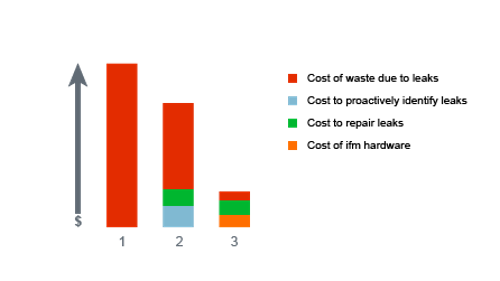- Energy optimization
- Compressed air
Optimize compressed air usage: Save on manufacturing costs
Manufacturers can reduce their costs by optimizing compressed air usage. Compressed air leaks often waste 20-30% of the compressor’s output. Using air flow meters to monitor and address inefficiencies is a new approach to cutting energy costs and increasing efficiency.
Compressed air usage and potential for savings: Official statistics
The US Department of Energy conducted a survey on compressed air systems. It found that compressed air systems account for 10% of all electricity used in manufacturing industries. 70% of all US manufacturing plants have a compressed air system and 50% of those plants have opportunities for large energy savings with low project costs. Source: Assessment of the Market for Compressed Air Efficiency Services – Energy.gov
Low awareness of energy optimization opportunities
In manufacturing plants, awareness of compressed air efficiency is low. The primary objective is supplying a reliable and consistent source of air. Some manufacturers have service contract for equipment, but few address efficiency. 35% of manufacturers conduct leak prevention programs and 57% of manufacturers have taken no action to improve efficiency. Source: Assessment of the Market for Compressed Air Efficiency Services – Energy.gov
Leak detection using air flow meters with multiple sensors
Air flow meters with multiple sensors continuously monitor the flow rate, pressure, volume and temperature of compressed air and specialty gas. Flow meters from ifm use IO-Link software to provide real-time analytics.
As a restult, you can be notified immediately of a leak or inefficiency, allowing you to quickly address the concern before it becomes more severe and costly to repair.
Investing in leak monitoring vs. buying new compressors
A study conducted by the US Department of Energy found that 80% of compressor upgrade recommendations do not require investment in new compressors, and instead are addressed through low cost system upgrades and an effective leak monitoring and repair program.
The estimates in the table below are widely accepted by the US Department of Energy as well as compressed air industry specialists. The estimates assume sharp orifices, well-rounded orifices could be 60% higher than listed.
Estimated air flow losses due to leakage
| Hole size | Compressed air pressure | ||
|---|---|---|---|
| 80 psi | 90 psi | 100 psi | |
| 1/16" | 3.2 cfm | 3.5 cfm | 3.8 cfm |
| 1/8" | 12.7 cfm | 14.1 cfm | 15.4 cfm |
| 1/4" | 51 cfm | 56 cfm | 62 cfm |
Continuously monitoring the flow rate, pressure, volume and temperature of compressed air and specialty gas with an air flow meter is a new approach to reducing manufacturing costs.
How are leaks found?
There are three basic leak detection strategies. Each have costs associated with them.
- No strategy – High energy cost, waste due to leaks accounts for 25 – 30 % of energy cost.
- Preventative– Some sort of leak detection program is in place. Inspections are scheduled on a monthly or quarterly basis. Traditional methods, such as soapy water at joints or ultrasonic detectors, are used. As leaks are found, they are repaired.
- Predictive – Continuous monitoring of compressed air usage quickly identifies areas of leakage. Maintenance is scheduled to minimize downtime. Very often, the capital investment of a new compressor is postponed.
